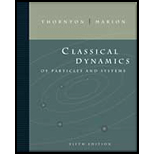
Classical Dynamics of Particles and Systems
5th Edition
ISBN: 9780534408961
Author: Stephen T. Thornton, Jerry B. Marion
Publisher: Cengage Learning
expand_more
expand_more
format_list_bulleted
Concept explainers
Question
Chapter 2, Problem 2.11P
To determine
Show that the distance the particle falls in accelerating from
Expert Solution & Answer
Trending nowThis is a popular solution!

Students have asked these similar questions
Consider a rubber rod that has been rubbed with fur to give the rod a net negative charge, and a glass rod that has been rubbed with silk to give it a net positive charge. After being charged by contact by the fur and silk...?
a. Both rods have less mass
b. the rubber rod has more mass and the glass rod has less mass
c. both rods have more mass
d. the masses of both rods are unchanged
e. the rubber rod has less mass and the glass rod has mroe mass
8) 9)
10)
11)
12)
13)
14)
15)
Chapter 2 Solutions
Classical Dynamics of Particles and Systems
Ch. 2 - Prob. 2.1PCh. 2 - Prob. 2.2PCh. 2 - If a projectile is fired from the origin of the...Ch. 2 - A clown is juggling four balls simultaneously....Ch. 2 - A jet fighter pilot knows he is able to withstand...Ch. 2 -
In the blizzard of ’88, a rancher was forced to...Ch. 2 - Prob. 2.7PCh. 2 - A projectile is fired with a velocity 0 such that...Ch. 2 - Consider a projectile fired vertically in a...Ch. 2 - Prob. 2.11P
Ch. 2 - A particle is projected vertically upward in a...Ch. 2 -
A particle moves in a medium under the influence...Ch. 2 - A projectile is fired with initial speed 0 at an...Ch. 2 -
A particle of mass m slides down an inclined...Ch. 2 - A particle is projected with an initial velocity 0...Ch. 2 - A strong softball player smacks the ball at a...Ch. 2 - Prob. 2.19PCh. 2 - A gun fires a projectile of mass 10 kg of the type...Ch. 2 - Prob. 2.21PCh. 2 - Prob. 2.22PCh. 2 - A skier weighing 90 kg starts from rest down a...Ch. 2 - A block of mass m = 1.62 kg slides down a...Ch. 2 - A child slides a block of mass 2 kg along a slick...Ch. 2 - A rope having a total mass of 0.4 kg and total...Ch. 2 - A superball of mass M and a marble of mass m are...Ch. 2 - An automobile driver traveling down an 8% grade...Ch. 2 - A student drops a water-filled balloon from the...Ch. 2 - Prob. 2.31PCh. 2 - Two blocks of unequal mass are connected by a...Ch. 2 - A particle is released from rest (y = 0) and falls...Ch. 2 - Perform the numerical calculations of Example 2.7...Ch. 2 - Prob. 2.36PCh. 2 - A particle of mass m has speed υ = α/x, where x is...Ch. 2 - The speed of a particle of mass m varies with the...Ch. 2 - A boat with initial speed υ0 is launched on a...Ch. 2 - A train moves along the tracks at a constant speed...Ch. 2 - Prob. 2.42PCh. 2 - Prob. 2.45PCh. 2 - Prob. 2.46PCh. 2 - Consider a particle moving in the region x > 0...Ch. 2 - Prob. 2.48PCh. 2 - Prob. 2.49PCh. 2 - According to special relativity, a particle of...Ch. 2 - Let us make the (unrealistic) assumption that a...Ch. 2 - A particle of mass m moving in one dimension has...Ch. 2 - A potato of mass 0.5 kg moves under Earth’s...Ch. 2 - Prob. 2.55P
Knowledge Booster
Learn more about
Need a deep-dive on the concept behind this application? Look no further. Learn more about this topic, physics and related others by exploring similar questions and additional content below.Similar questions
- Mick and Rick are twins born on Earth in the year 2175. Rick grows up to be an Earth-bound robotics technician while Mick becomes an intergalactic astronaut. Mick leaves the Earth on his first space mission in the year 2200 and travels, according to his clock, for 10 years at a speed of 0.75c. Unfortunately, at this point in his journey, the structure of his ship undergoes mechanical breakdown and the ship explodes. How old is Rick when his brother dies?arrow_forwardHi, I have canceled, why did you charge me again?arrow_forwardNo chatgpt pls will upvotearrow_forward
arrow_back_ios
SEE MORE QUESTIONS
arrow_forward_ios
Recommended textbooks for you
 Classical Dynamics of Particles and SystemsPhysicsISBN:9780534408961Author:Stephen T. Thornton, Jerry B. MarionPublisher:Cengage Learning
Classical Dynamics of Particles and SystemsPhysicsISBN:9780534408961Author:Stephen T. Thornton, Jerry B. MarionPublisher:Cengage Learning Physics for Scientists and Engineers: Foundations...PhysicsISBN:9781133939146Author:Katz, Debora M.Publisher:Cengage Learning
Physics for Scientists and Engineers: Foundations...PhysicsISBN:9781133939146Author:Katz, Debora M.Publisher:Cengage Learning Principles of Physics: A Calculus-Based TextPhysicsISBN:9781133104261Author:Raymond A. Serway, John W. JewettPublisher:Cengage Learning
Principles of Physics: A Calculus-Based TextPhysicsISBN:9781133104261Author:Raymond A. Serway, John W. JewettPublisher:Cengage Learning University Physics Volume 3PhysicsISBN:9781938168185Author:William Moebs, Jeff SannyPublisher:OpenStax
University Physics Volume 3PhysicsISBN:9781938168185Author:William Moebs, Jeff SannyPublisher:OpenStax Physics for Scientists and EngineersPhysicsISBN:9781337553278Author:Raymond A. Serway, John W. JewettPublisher:Cengage Learning
Physics for Scientists and EngineersPhysicsISBN:9781337553278Author:Raymond A. Serway, John W. JewettPublisher:Cengage Learning Physics for Scientists and Engineers with Modern ...PhysicsISBN:9781337553292Author:Raymond A. Serway, John W. JewettPublisher:Cengage Learning
Physics for Scientists and Engineers with Modern ...PhysicsISBN:9781337553292Author:Raymond A. Serway, John W. JewettPublisher:Cengage Learning

Classical Dynamics of Particles and Systems
Physics
ISBN:9780534408961
Author:Stephen T. Thornton, Jerry B. Marion
Publisher:Cengage Learning

Physics for Scientists and Engineers: Foundations...
Physics
ISBN:9781133939146
Author:Katz, Debora M.
Publisher:Cengage Learning

Principles of Physics: A Calculus-Based Text
Physics
ISBN:9781133104261
Author:Raymond A. Serway, John W. Jewett
Publisher:Cengage Learning

University Physics Volume 3
Physics
ISBN:9781938168185
Author:William Moebs, Jeff Sanny
Publisher:OpenStax

Physics for Scientists and Engineers
Physics
ISBN:9781337553278
Author:Raymond A. Serway, John W. Jewett
Publisher:Cengage Learning

Physics for Scientists and Engineers with Modern ...
Physics
ISBN:9781337553292
Author:Raymond A. Serway, John W. Jewett
Publisher:Cengage Learning